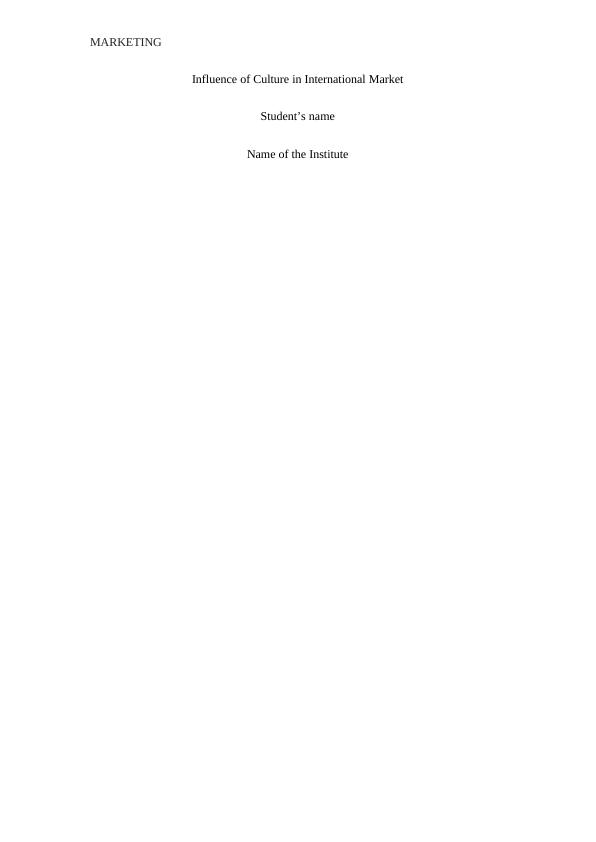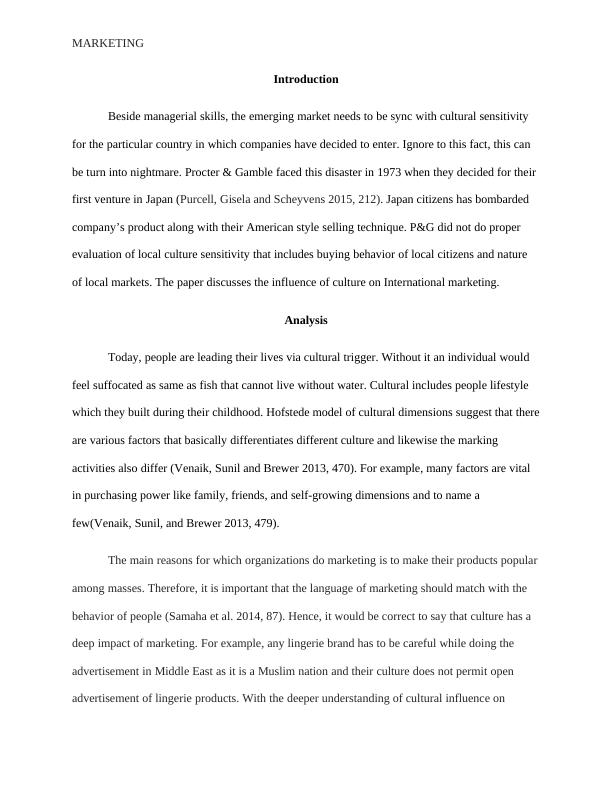Influence of Culture in International Market
Added on 2021-05-31
8 Pages1459 Words98 Views
MARKETINGInfluence of Culture in International Market Student’s nameName of the Institute

MARKETINGExecutive SummaryThis report highlights that international marketing is strongly influenced by Culture dimensions. The paper discusses the cultural model of Hofstede and Trompenaars. The Trompenaars’ model of national culture differences has seven dimensions. There are five orientations covering the ways in which human beings deal with each other, one which deals with time, and one which deals with the environment. The first dimension of Trompenaars model is universalism versus particularism. It means that some culture use universalism approach that says that ideas can be applied anywhere, and particularism suggests that ideas are particular in nature. The second dimension is Individualism versus Communitarianism. The dimension of individualism suggest that people like to do work along and the dimension of communitarianism suggest that people like to work in group. The third dimension is neutral versus emotional. The neutral people are not emotional and take decision based on facts. The fourth dimension is specific versus diffuse. The specific culture takes a specific approach for any work. The fifth dimension is achievement versus ascription. The culture of achievement focuseson end objective and the achievements. In an ascription culture, status is based on who or what a person is rather than what a person has achieved. The sixth dimension is sequential versus synchronic. A sequential time culture is the one in which the people like events to happen in a chronological order. Whereas in synchronic culture people prefer multitasking. The seventh dimension is internal versus external control.

MARKETINGIntroductionBeside managerial skills, the emerging market needs to be sync with cultural sensitivity for the particular country in which companies have decided to enter. Ignore to this fact, this can be turn into nightmare. Procter & Gamble faced this disaster in 1973 when they decided for their first venture in Japan (Purcell, Gisela and Scheyvens 2015, 212). Japan citizens has bombarded company’s product along with their American style selling technique. P&G did not do proper evaluation of local culture sensitivity that includes buying behavior of local citizens and nature of local markets. The paper discusses the influence of culture on International marketing. Analysis Today, people are leading their lives via cultural trigger. Without it an individual would feel suffocated as same as fish that cannot live without water. Cultural includes people lifestyle which they built during their childhood. Hofstede model of cultural dimensions suggest that thereare various factors that basically differentiates different culture and likewise the marking activities also differ (Venaik, Sunil and Brewer 2013, 470). For example, many factors are vital in purchasing power like family, friends, and self-growing dimensions and to name a few(Venaik, Sunil, and Brewer 2013, 479). The main reasons for which organizations do marketing is to make their products popularamong masses. Therefore, it is important that the language of marketing should match with the behavior of people (Samaha et al. 2014, 87). Hence, it would be correct to say that culture has a deep impact of marketing. For example, any lingerie brand has to be careful while doing the advertisement in Middle East as it is a Muslim nation and their culture does not permit open advertisement of lingerie products. With the deeper understanding of cultural influence on

End of preview
Want to access all the pages? Upload your documents or become a member.
Related Documents
Managing Across Cultures on Business Case Study 2022lg...
|6
|1266
|79
Cultural Dissimilarities Exist Between Different Countrieslg...
|7
|1198
|24
Cultural Differences Between Ethiopia and Romanialg...
|13
|3080
|65
Cross Cultural Managementlg...
|7
|1727
|492
A Reflection on Cultural Differences in an Organisationlg...
|9
|1943
|270
Trompenaars & Hampden-Turner Dimensions Model of Culturelg...
|14
|1368
|326
